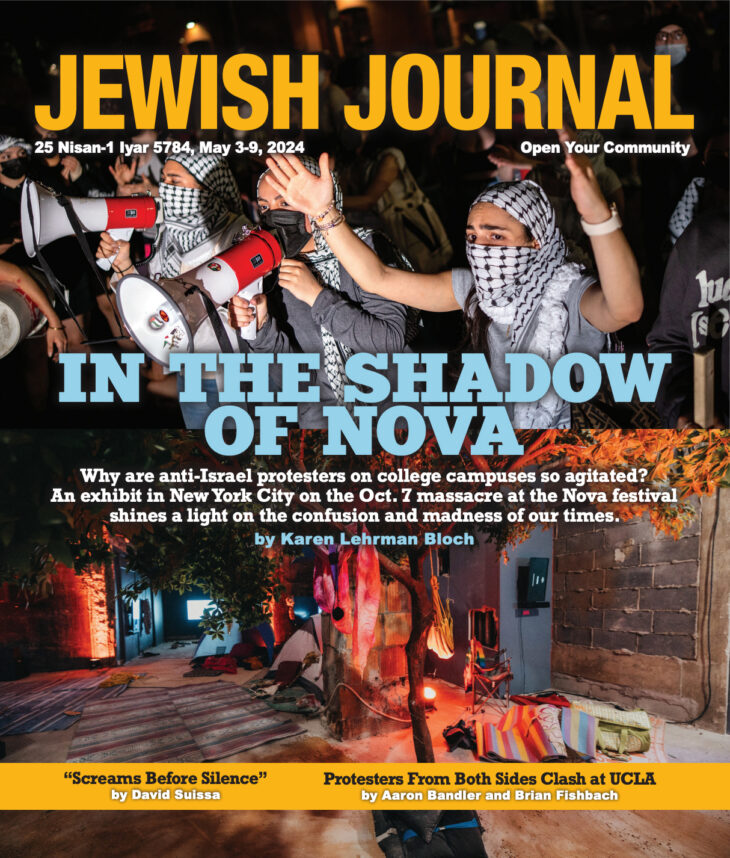Nearly 300 years ago, two Jewish artists inscribed their names on the upper walls of the Gwozdziec Synagogue, located in a bustling trading town in the Polish-Lithuanian countryside.
With its spectacular, newly remodeled towering ceiling, a painted tapestry of luminous colors and vivid imagery, the Gwozdziec Synagogue was among the most magnificent of Poland’s 17th- and 18th-century wooden synagogues built during the golden age of Polish Jewry.
At one time, there were some 200 of these architectural gems, unique to the region. None survived the Nazi occupation of Poland.
Centuries after they were built, in the summer of 2012, Helena Lipstadt, a poet and garden designer in Hollywood whose parents were Polish-born Holocaust survivors, took part in a unique project to re-create the Gwozdziec Synagogue’s massive cascading wooden roof and elaborately painted ceiling.
It was an unlikely dream to bring back to life this nearly lost history.
The ambitious undertaking was initiated and led by Rick and Laura Brown, Boston-based artists and educators, in partnership with Warsaw’s new POLIN Museum of the History of Polish Jews. All work was done by hand in workshops across Poland over three summers, using traditional methods and materials of the sort that would have been used when the original was built. The roof construction was done in partnership with the Timber Framers Guild, based on the East Coast.
The dazzling structure and a re-creation of the intricately hand-carved, painted bimah is now the much-heralded centerpiece of the permanent exhibit at the POLIN museum, which opened last fall.
The story of the improbable, decade-long journey that led to the creation of this stunning installation is told in “Raise the Roof,” a new documentary by Boston-based father-son filmmakers Cary and Yari Wolinsky, which will be shown May 18-19 at screenings at six Laemmle theaters in Los Angeles.
 The 85-minute Trillium Studios film, distributed by the National Center for Jewish Film at Brandeis University, is now bringing this little-known but significant piece of Polish-Jewish history beyond the borders of the museum in Warsaw, Laura Brown observed. “The story belongs to the world,” she said in an interview with the Journal.
The 85-minute Trillium Studios film, distributed by the National Center for Jewish Film at Brandeis University, is now bringing this little-known but significant piece of Polish-Jewish history beyond the borders of the museum in Warsaw, Laura Brown observed. “The story belongs to the world,” she said in an interview with the Journal.
“The recovery of this lost object is an epic story,” according to Barbara Kirshenblatt-Gimblett, program director of the core exhibition of the POLIN museum, one of the scholars interviewed in the film. She describes the painted ceiling as a “celestial canopy,” reflecting a rich period of Polish-Jewish history that contrasts sharply with the stereotypical images of impoverished Polish-Jewish shtetl life.
In the film, the Browns, who are neither Jewish nor of Polish descent, recall that when they first learned about the history of Poland’s wooden synagogues, in 2003, they were instantly drawn to their beauty and to the story of their tragic destruction. Through their educational nonprofit, Handshouse, they initiated a project to collaborate with other scholars and artisans to develop programs to heighten interest in the synagogues.
Among their key partners and sources of scholarship was Thomas C. Hubka, author of “Resplendent Synagogue,” on the Gwozdziec Synagogue. In the film, Hubka sheds light on the unique architecture of the wooden synagogues.
“The big dream was that one day we were going to build one of these synagogues, as accurately as possible, in Poland,” Rick Brown says in the film.
Over the years, the Browns pursued the dream. In Handshouse workshops and in courses at Massachusetts College of Art, where they are longtime faculty members, the Browns, their students and other artisans built authentic models of several synagogues and eventually a half-scale version of the Gwozdziec Synagogue’s painted ceiling. In 2006, they re-created the Gwozdziec bimah. The models were exhibited in museums and Jewish centers around the country.
Along the way, they and their students learned about the social, political and economic forces that were present at the time, Rick Brown said in an interview.
The film parallels the discovery that was central to this project, according to Yari Wolinsky, who edited the film, his first feature. “You go through the process as the students did, learning a bit, needing to know more, why they were built this way, what did the paintings mean, what were the tools they used,” he said in a phone interview.
“You also come out” with “a good sense of the world around it,” he said.
The Wolinskys, neighbors of the Browns in a suburb of Boston, watched over the years as the Browns’ passion for the project deepened. In 2006, Yari Wolinsky made a short film that chronicled the building of the bimah.
In 2011, when the Browns partnered with the POLIN museum to re-create the synagogue roof and ceiling, Yari Wolinsky sensed the significance of the moment. “This was a once-in-a-lifetime story that was unfolding on a world stage,” he said.
The project’s focus on how Jews lived in Poland — and not how they died — struck a chord with Lipstadt, she said.
When she was growing up, the subject of Poland was taboo. “My father would say, ‘We’re not Polish. We’re Jewish,’ ” reflecting his sense of the instability Jews faced in the world, she said.
But Lipstadt was drawn to know more about her Jewish-Polish roots and traveled to Poland in 2011 with her grown nephew to seek out the places where their family lived.
The painting workshop Lipstadt took part in was held in the Szczebrzeszyn Synagogue, now renovated and used as a Jewish cultural center. “It was a powerful experience,” she said.
“It made it real,” Lipstadt said. “These were towns where Jews lived. This building was very prominent, in the center of town. It made it so clear how integral Jewish life was to Polish life.”
For more information, screenings and to buy tickets, visit polishsynagogue.com.





















 More news and opinions than at a Shabbat dinner, right in your inbox.
More news and opinions than at a Shabbat dinner, right in your inbox.